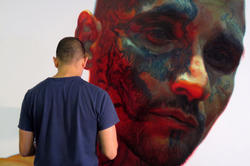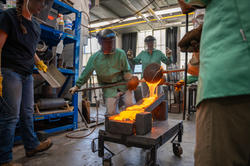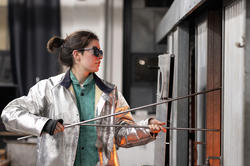The Texas native and Illustration alum shared sage advice with current students about sustaining a healthy creative practice.
Experimental Glass Course at RISD Introduces New Ideas and Material Understandings

“The water content in the sand is important,” Glass department faculty member Ashley Harris MFA 21 GL explains to the students in her Interdisciplinary Hot Casting course. “You can check the consistency by tossing a handful of sand into the air three times. It should break apart on the third toss.”
The class has been divided into two teams, and each team is sifting sand using shovels, wooden blocks, and sieves in the department’s Kiln Room before heading to the Hot Shop, where they’ll learn the process of sand casting. Most of the students are not Glass majors, so they’re eager to hear Harris’ studio tips, which she learned as a grad student in the department. “Many of the techniques and processes for working with glass originated here at RISD in the 1960s, when [celebrated studio glass artist and RISD alum] Dale Chihuly MFA 68 CR/HD 86 started the department,” Harris says.
Her hands-on, experimental course gives students the opportunity to investigate a range of traditional and non-traditional hot glass casting methods and mold materials. The goal is to introduce them to a variety of artistic approaches, get them familiar with the innate properties of glass and the extremely collaborative nature of glass work, and encourage them to use these techniques as the basis for developing new ideas and material understandings.


The class began with a hot casting assignment based on late sculptor Richard Serra’s widely employed Verblist. The artist compiled a series of “actions to relate to oneself, material, place, and process” that continue to inspire artists today: to roll, to crease, to fold, to store, to bend, to shorten, etc. Harris charged the class with selecting one of these verbs to elicit a response from the glass.
Junior Jino Son 27 SC used the verb to scatter to create his first piece exploring what happens when water meets hot glass. “When I dropped water into molten glass, it boiled and scattered, creating a dynamic reaction filled with sound and motion,” he explains. His piece—a telescope-like object containing the glass and a speaker—represents the whole process, “from the moment of impact to the calm aftermath.”
Grad student Kevin Xiao MID 27 explored notions of compression and tension in his work, “showing how the two forces work together and introduce internal conflict into the piece.” Architecture student Marianne Dang MArch 28 reflected on the verb to impress when they free-poured a series of organic, spherical objects. “I was thinking about how I could impress upon the glass and how it could impress upon me,” Dang says. “In a sense, I’m creating a relationship with the glass using my body as mediator.”


Back in the Hot Shop, the students pass around the objects they’re intending to cast in the sand. One student brought an orange; another the tail of a large fish he caught in the bay. Harris shares another technique with the class, this one to prevent the sand from fusing with the molten glass. After the objects are pressed into the sand to form a cavity that will be filled with glass, she sprays the sand with a mixture of molasses and water and then heats it up with a blowtorch.
Students take turns scooping the molten glass from the glory hole, snipping the excess with sheers, and ferrying the hot objects into an annealing oven where they will gradually cool down. As the semester continues, the class will move into developing cold shop techniques, creating their own Zircon molds, and adapting industry hot shop techniques. They’ll finish the term with an individual project of their choosing that demonstrates their mastery of one or more of the techniques they studied.
Top image: Faculty member Ashley Harris uses a blowtorch to ensure even temperature after ladling molten glass into the sand.
Simone Solondz / photos by Kaylee Pugliese
October 16, 2025


